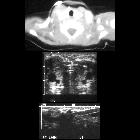Elastofibroma dorsi





























Elastofibroma dorsi is a benign soft-tissue tumor with a characteristic location and imaging appearance.
Epidemiology
It is more frequently seen in older women, with a reported female predilection of 5-13:1. The estimated mean age at diagnosis is around 65-70 years.
Clinical presentation
Elastofibroma dorsi is classically located in the infrascapular regions, deep to the serratus anterior and latissimus dorsi musculature. Unilateral masses have a slight right-sided predilection, but up to 30% of elastofibromas are bilateral .
In many cases the lesions are asymptomatic. Up to 50% of patients describe localized symptoms including:
- pain, especially on movement
- sensation of clicking, snapping, or clunking of the scapula
Pathology
Elastofibroma dorsi is composed of fibrous tissue with internal fatty streaks, which accounts for its imaging appearance. It is thought that it results from recurrent friction in the area between inferior scapula and posterior chest wall .
Radiographic features
Ultrasound
Ultrasound demonstrates a well-defined multi-layered pattern of hypoechoic linear areas of fat deposition intermixed with echogenic fibroelastic tissue.
CT
These masses typically appear as poorly defined soft-tissue masses with attenuation similar to that of the adjacent skeletal muscle. They are located in the infrascapular or subscapular region.
MRI
MRI appearance matches that of the underlying pathology. The mass appears as alternating fibrous and fatty components.
Although the borders of these masses are relatively well defined, no capsule can be identified.
- T1
- fibrous component: isointense to muscle
- fatty component: high signal
- T2
- fibrous component: isointense to muscle
- fatty component: high signal
- T1 C+ (Gd): heterogeneous low level enhancement
PET-CT
Elastofibroma dorsi frequently shows mild to moderate FDG uptake, which should not be misinterpreted as a malignant lesion .
History and etymology
It was first described by OH Jarvi and AE Saxon in 1959 .
Siehe auch:
und weiter:

 Assoziationen und Differentialdiagnosen zu Elastofibroma dorsi:
Assoziationen und Differentialdiagnosen zu Elastofibroma dorsi:
